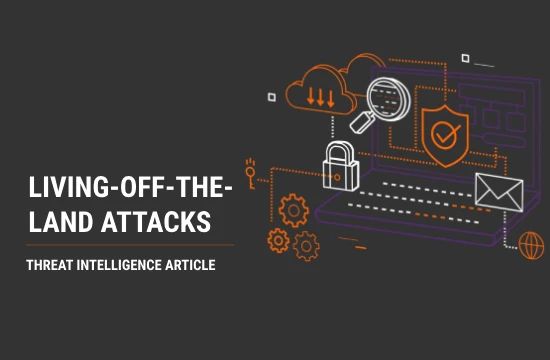What are Living Off The Land (LOTL) Attacks?
Living Off The Land (LOTL) attacks are a sophisticated cyber threat where attackers use legitimate system tools and built-in applications to carry out malicious activities. Unlike traditional malware attacks that rely on external executable files, LOTL attacks exploit pre-installed utilities such as PowerShell, Windows Management Instrumentation (WMI),and scripting frameworks to execute malicious commands while avoiding detection by traditional security solutions. By leveraging trusted programs, cybercriminals can operate under the radar, bypassing antivirus software and endpoint detection systems that typically flag unfamiliar or suspicious files.
The primary goal of LOTL attacks is to blend in with normal system activities, making them difficult to detect. Attackers use administrative tools to move laterally within a network, escalate privileges, exfiltrate data, or deploy more advanced threats such as ransomware. Because these attacks do not rely on traditional malware signatures, conventional security measures that focus on file-based threats often struggle to identify and mitigate LOTL techniques. This makes them particularly dangerous for organizations with inadequate behavioral-based security solutions.
One of the most well-known techniques associated with LOTL attacks is the use of PowerShell, a powerful command-line tool built into Windows operating systems. Attackers use PowerShell scripts to execute malicious payloads, modify system settings, or extract sensitive data. Similarly, WMI is often exploited to execute commands remotely, collect system information, and automate malicious processes without dropping additional files onto the system. Other commonly used tools include Microsoft’s PsExec for remote execution and LOLBins (Living Off The Land Binaries) that are typically used for legitimate administrative purposes but can be weaponized by threat actors.
LOTL attacks are frequently linked to advanced persistent threats (APTs),where cybercriminals maintain long-term access to a network without triggering security alarms. These attacks are often used for espionage, data exfiltration, and sabotage. High-profile cyber incidents involving LOTL techniques have targeted industries such as finance, healthcare, and government agencies, proving that no organization is immune.
Defending against LOTL attacks requires a shift from traditional signature-based detection to behavior-based threat hunting. Organizations must implement endpoint detection and response (EDR) solutions, monitor abnormal command-line activities, and restrict access to administrative tools unless absolutely necessary. Security teams should also enforce least privilege access and regularly audit system logs for suspicious activity. By understanding and proactively mitigating LOTL attack techniques, businesses can reduce the risk of falling victim to these highly evasive threats.
Common Techniques Used in LOTL Attacks
Living Off The Land (LOTL) attacks rely on various techniques that exploit built-in system tools and legitimate software to execute malicious activities while remaining undetected. Instead of using traditional malware that can be flagged by antivirus programs, attackers take advantage of trusted utilities to carry out their operations stealthily. Understanding these common techniques is essential for detecting and mitigating LOTL threats before they cause significant damage.
One of the most widely used techniques in LOTL attacks is the abuse of PowerShell. PowerShell is a powerful scripting language built into Windows that allows administrators to automate system tasks. Cybercriminals use PowerShell scripts to download and execute malicious payloads, modify system configurations, or exfiltrate data. Because PowerShell is a trusted tool, its misuse can easily go unnoticed if organizations do not monitor command-line activity.
Windows Management Instrumentation (WMI) is another commonly exploited tool in LOTL attacks. WMI allows administrators to query and manage system components, but attackers use it for remote code execution, lateral movement, and persistence. WMI can be leveraged to execute malicious scripts without creating new processes, making it harder for traditional security tools to detect suspicious behavior.
Another technique involves using LOLBins (Living Off The Land Binaries),which are legitimate system binaries that can be repurposed for malicious intent. Attackers exploit these pre-installed executables to bypass security controls, execute commands, or download additional payloads. Examples of LOLBins include rundll32.exe, mshta.exe, and certutil.exe, all of which have legitimate administrative functions but can be manipulated to execute malicious code.
Credential dumping is another key LOTL tactic, where attackers extract stored credentials from system memory using tools like Mimikatz. Once credentials are obtained, attackers can move laterally within a network, escalate privileges, and access sensitive systems without triggering traditional authentication alerts.
Remote administration tools such as PsExec and Windows Remote Management (WinRM) are often used for executing commands on remote machines. Attackers exploit these tools to spread across a network, deploy ransomware, or exfiltrate sensitive information.
Fileless malware is also a major component of LOTL attacks. Instead of writing malicious files to disk, attackers inject code directly into memory using tools like PowerShell, making it nearly impossible for traditional antivirus solutions to detect or remove the threat.
To defend against these techniques, organizations must implement behavior-based threat detection, restrict access to administrative tools, and closely monitor system logs for anomalies. Security teams should also enforce the principle of least privilege to limit the potential impact of compromised accounts.
How to Detect and Prevent LOTL Attacks
Detecting and preventing Living Off The Land (LOTL) attacks is challenging because these attacks exploit legitimate system tools and processes rather than relying on traditional malware. Since they do not involve easily identifiable malicious files, organizations must shift from signature-based detection to behavior-based security strategies. Understanding how to recognize and mitigate these threats is crucial for strengthening cybersecurity defenses.
One of the most effective ways to detect LOTL attacks is through behavioral analysis and anomaly detection. Security teams should monitor system activity for unusual patterns, such as unexpected use of PowerShell, WMI, or command-line tools. These legitimate tools are often misused by attackers to execute malicious payloads, so monitoring their execution, especially in non-administrative contexts, can help flag potential threats. Endpoint detection and response (EDR) solutions can provide real-time visibility into suspicious behavior and help detect command-line executions associated with known attack techniques.
Logging and auditing system activities play a critical role in identifying LOTL attacks. Organizations should enable logging for PowerShell script execution, process creation, and network connections. Windows Event Logs, Sysmon, and Security Information and Event Management (SIEM) solutions can help security teams analyze activity and detect anomalies. For example, if a rarely used system tool suddenly initiates network communication or executes suspicious commands, it may indicate an ongoing LOTL attack.
Another key prevention measure is the restriction of administrative privileges. Many LOTL attacks rely on elevated permissions to execute commands, move laterally, and access sensitive data. Implementing the principle of least privilege (PoLP) ensures that users and processes only have the access necessary to perform their intended functions. Regularly auditing user privileges and restricting access to high-risk utilities such as PowerShell, WMI, and remote administration tools can reduce the attack surface.
Application whitelisting and software restriction policies (SRP) can also be effective in preventing LOTL attacks. By only allowing approved applications and scripts to run, organizations can block unauthorized use of built-in tools commonly exploited by attackers. PowerShell execution policies can be configured to restrict unsigned scripts, and tools like AppLocker can prevent the execution of malicious scripts and binaries.
Network segmentation is another effective defense against LOTL attacks. By limiting communication between systems, organizations can prevent attackers from easily moving laterally across a network. Implementing multi-factor authentication (MFA) can also help mitigate credential theft, which is often used in conjunction with LOTL techniques.
Ultimately, preventing LOTL attacks requires a proactive security strategy that combines continuous monitoring, behavioral analytics, and strict access controls. Organizations that invest in these measures will be better equipped to detect and defend against these stealthy and highly evasive threats.






